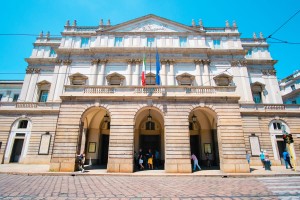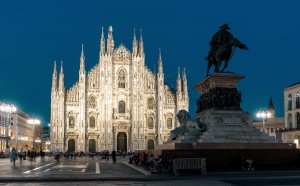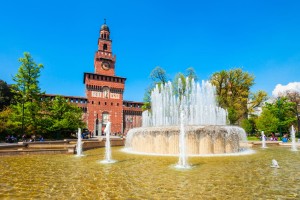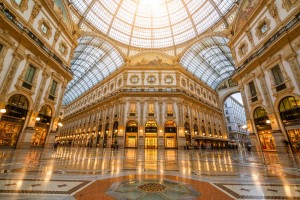City of fashion, of industry and media – Milan has a special role in Italy and beyond. The country’s second-largest city and capital of Lombardy with approx. 1.4 million inhabitants is the hub of the north, situated ideally, and a point of attraction for people from across the globe. Milan or Milano, to use its Italian name, derives from the Latin word “Mediolanum”, meaning “in the middle of the plain”. Its suburbs extend to other prominent city of arts, such as Como and Bergamo, with the entire greater area emitting a truly special atmosphere. We have picked a few favourites you absolutely must check out during your next visit of the city of arts that is Milan.
From Celtic settlement to industrialised metropolis

©Bigstock.com/uatp1
Sure, we always say something along those lines, but Milan’s history really is exquisitely exciting. First settlement of the area by the Insubres dates to around 400 BC. The Romans conquered this Celtic settlement just under 200 years later and renamed it Mediolanum – you might have heard that word before. However, it would take a very long time until today’s Milan gained any significance. West Roman emperors resided here in the 4th century AD before the imperial court was moved to Ravenna. There are hardly any traces of ancient Roman architecture left – Colonne di San Lorenzo being a noteworthy exception – as the Ostrogoths completely destroyed Milan 539. The city met a similar fate over 600 years later at the hands of Barbarossa. However, its allied cities Mantua, Brescia, Verona and Bergamo started the reconstruction process only five years later.
Said reconstruction finally brought the desired boom. Milan assumed the leading role in the Lombard League from 1167 onward and became a signoria after gaining its independence. After having been conquered by the House of Sforza in 1450, Milan was converted into an astonishing Renaissance gem only to be hotly contested soon after. All of Northern Italy fell to the Habsburg in 1525, was given to the Spanish line soon after and only returned to the Austrian side in the early 18th century. Napoleon would later get his piece of Milan before it was passed to Austria – again – and eventually incorporated into the Kingdom of Italy. Immigrants from other parts of the country caused Milan to grow tremendously during the industrialisation with another boom period following the end of the Second World War. Even though the number of inhabitants sunk due to migration to the great metropolitan area, Milan remains a giant.
Milan, city of churches

©Bigstock.com/scaliger
Barbarossa only spared a few churches when he conquered and completely destroyed the city 1162. That is certainly part of why there is such a plethora of sacral buildings in Milan. Here are some of our favourites:
- Cathedral: The magnificent façade of the cathedral was only completely in Napoleon times – quite astounding considering that construction of this monumental building began more than 400 years earlier. The Duomo di Milano is an absolute must-visit with its stunning details, grand dimensions, and the precious cathedral treasury.
- Santa Maria presso San Satiro: This sacral complex grants you insights into the city’s architectural history of churches. The small central-plan building dates to the 9th century and retained its original form at the core. The Church of Our Lady from the Renaissance features a rather exciting layout and grand trompe-l’œil in the choir. A grand example of major Renaissance central-plan buildings is the sacristy.
- San Lorenzo Maggiore: Despite having been extensively redesigned and restored from the 12th century onward due to fires and collapses, this basilica still carries its original 4th century tetraconch layout – an impressive central-plan building with four apses and four corner towers.
- Sant’Ambrogio: This church, named after its constructor, St. Ambrose, dates to pre-Christian times as well. It was extended from the 8th century onward to meet the requirements of the newly founded Benedictine abbey. Even though coating covers the ancient pillars, the ostentatious endowment and the shape carry the flair of said origins.
- San Maurizio: Also known as the “Sistine Chapel of Milan”, San Maurizio was originally built as a minster in the 16th The abbey does not exist anymore, but the grand paintings by important Lombard painters most certainly do. Do not miss out on this artful highlight!
- Santa Maria delle Grazie: You might already be familiar with this UNESCO World Heritage Site. While Leonardo da Vinci’s “The Last Supper” might be the main attraction, you certainly should not sleep on the stylistic plurality with Gothic and Renaissance elements.
Palaces, galleries and culture

©Bigstock.com/saiko3p
We put sacred Milan on hold for now on focus on other buildings mostly built during a similar period, yet of a more secular nature. They are places where art and culture, splendour and expediency meet.
- Palazzo della Ragione: The horseman relief on the façade of the palace, often simply referred to as “Broletto”, depicts Oldrado da Tresseno who used to be podestà of Milan and initiated construction of this building. It used to be the site of markets, councils and court trials. Numerous frescoes await you on the inside.
- Castello Sforzesco: Head to the northwest of the old city for a genuine Renaissance gem. Francesco I of the House of Sforza had this fort built on the site of a destroyed Visconti castle. Situated ideally for defending against attacks from the outside and revolts from inside the walls, its massive walls now house numerous museums.
- Biblioteca Ambrosiana: Together with the art gallery and the art academy, this counter-reformation era library became a major cultural and scientific hub. Among the vast collection are fragments of the 5th century Ambrosian Iliad and a mathematical manuscript with drawings by Leonardo da Vinci.
- Scala: Those who have sung in Milan’s Scala have truly made it. Teatro alla Scala is one of the most famous operas in the world. It saw premieres of major pieces by Verdi, Rossini, Salieri and Puccini. The Scala now seats 2,030 spectators.
- Palazzo Reale: The Royal Palace might be an older building, but its contemporary look was only established during the reign of Empress Maria Theresia. Damaged, destroyed and restored several times, the palazzo reinvented itself in recent times to become a cultural hub.
New(er) Milan

©Bigstock.com/World Image
Milan never rests. The city developed rapidly after the Italian unification and the industrialisation. You can see just that when checking out the following highlights.
- Galleria Vittorio Emanuele II: Named after and opened by the unifier and King of Italy, this is not actually an art gallery, but the oldest still active shopping mall of the country. Mostly high-priced brand stores have found prestigious homes under the monumental glass roof.
- Cimitero Monumentale: A cemetery as a sight? This Romanesque Revival site fascinates in a plethora of manners. Many famous Italians, such as the poet Manzoni, the race car driver dynasty Ascari, and the Campari family, have found their final resting place here.
- Milano Centrale railway station: The industrialisation required a fully developed, expanded transportation network. Stazione di Milano was inspired by Washington D.C.’s Union Station. Opened in 1931, it now sees around 120 million passengers per year. A memorial on Binario 21 commemorates the horrors of the Holocaust.
- Pirelli Tower: Tremendous skyscrapers were one of the results of Milan’s resumed growth after the Second World War. Pirelli Tower was the city’s tallest building for a long time. The rather unique shape, the spectacular curtain wall and the rubbery floor covering create a fascinating architectural experience.
- Velasca Tower: Named after a 17th century Spanish governor of the city, this skyscraper near Milan Cathedral was built around the same time as the Pirelli Tower. It is renowned for its unusual mushroom shape. The “mushroom” itself is reserved for apartments while the floors below house stores and offices.
We could go on like this forever because Milan never sleeps. One of the current construction projects is the old exhibition centre, soon to be the home of Italy’s tallest building. As such, you will always be able to experience new things during every visit while also discovering many hidden old treasures. We recommend setting aside several days for a trip to Milan – or a full week to explore the wider metropolitan area and the neighbouring cities of arts. You will not regret it.